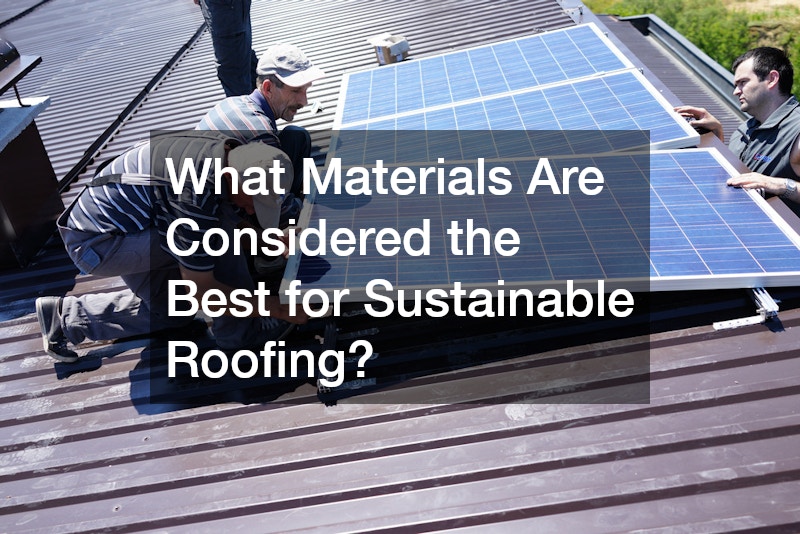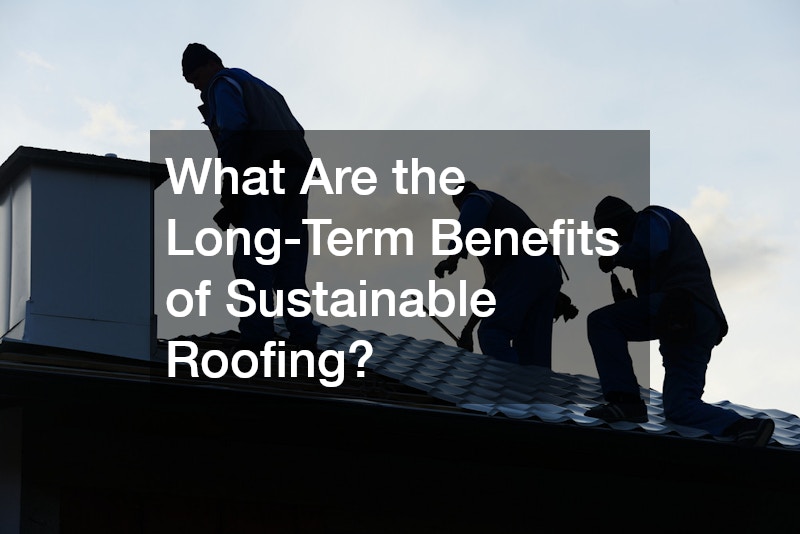Sustainable roofing practices are more crucial than ever in today’s environmentally conscious world. These practices not only help in conserving energy but greatly reduce a home’s ecological footprint. In this article, we will explore the most effective methods, materials, and considerations involved in creating a sustainable roofing system, focusing on roofing best practices.
As homeowners become increasingly aware of climate change, the demand for sustainable roofing options has grown. Roofing best practices involve choosing the right materials and methods that minimize environmental impact while maximizing energy efficiency. By understanding sustainable roofing, you are making a step towards a more eco-friendly home that supports the environment.
Creating a sustainable roofing system goes beyond just the selection of materials. It involves a holistic approach that includes proper installation, maintenance, and design. In this comprehensive article, we’ll cover various aspects of sustainable roofing to help you make informed decisions for your home.
What Materials Are Considered the Best for Sustainable Roofing?

When choosing materials for sustainable roofing, consider options that have a minimal environmental footprint. Recycled materials, such as recycled metal roofing, are a popular choice due to their longevity and recyclability. Additionally, materials like clay tiles and slate are natural, durable, and require minimal processing.
Roofing materials should not only be sustainable but also efficient in performance. For instance, metal roofs reflect solar heat, which can reduce cooling costs significantly. Flat roofing companies often recommend materials like TPO (thermoplastic polyolefin) that are both durable and reflective, contributing to sustainability.
Asphalt shingles, although not the most eco-friendly, have come a long way in sustainability with innovations that use recycled components. Roofing companies often include recycled-content asphalt shingles as a more affordable sustainable option. It’s crucial to understand the lifecycle of materials, which can impact long-term sustainability.
How Do Sustainable Roofing Practices Impact Energy Efficiency?
One of the key benefits of sustainable roofing practices is enhanced energy efficiency. By reflecting more sunlight and absorbing less heat, cool roofs keep buildings cooler and reduce the need for air conditioning. This not only lowers energy bills but also decreases greenhouse gas emissions.
Roofers often use energy-efficient materials that meet local energy codes and standards. Choosing the right material is vital, but proper roofing installation services also play a significant role in achieving optimal insulation and energy efficiency. An experienced local roofing contractor can guide you through selecting energy-efficient options suited to your climate.
Innovative designs like green roofs improve not only energy efficiency but also air quality by filtering pollutants. Green roofs provide natural insulation, keeping indoor temperatures stable and reducing reliance on heating and cooling systems. These roofing best practices exemplify how design and material choice can significantly benefit energy efficiency.
How Can I Achieve Proper Insulation with Eco-Friendly Roofing?
Proper insulation is crucial in any eco-friendly roofing system, as it helps maintain thermal integrity and energy efficiency. Utilizing reflective barriers and insulation material can drastically reduce heat transfer across the roof. Roofing companies emphasize the importance of insulation in achieving sustainable goals.
Materials like cellulose are popular among environmentally minded homeowners because they are made from recycled paper and offer excellent insulation properties. A local roofing contractor can provide insights on effective insulation methods that can pair with your sustainable roofing material. Implementing these techniques ensures enhanced performance and minimal environmental impact.
Sealing air leaks and using advanced technology insulations, such as spray foam, are strategies employed by roofing repair services to enhance energy efficiency. These methods ensure the home remains comfortable in various weather conditions. Roofing cleaning services also maintain effectiveness by preventing insulation damage.
What Are the Long-Term Benefits of Sustainable Roofing?

The long-term benefits of sustainable roofing are manifold, starting with durability. Materials like metal and clay tile have exceptionally long lifespans, reducing the need for frequent replacements. This means less waste and reduced environmental impact, aligning with key roofing best practices.
Cost savings are another significant benefit, as sustainable roofs typically lead to lower energy bills. The initial investment in sustainable materials can be higher, but the savings over time and incentives often make it a wise financial decision. Roofing best practices emphasize considering long-term savings as part of the overall value.
Finally, the environmental impact of sustainable roofing cannot be overstated. By choosing eco-friendly materials, homeowners contribute to reducing emissions, conserving resources, and promoting a healthier planet. These practices lead to the preservation of biodiversity and better water management, crucial for sustainable living.
What Is the Role of Roof Design in Sustainable Practices?
Roof design plays a vital role in sustainable practices, influencing energy efficiency, material efficiency, and aesthetic value. Innovative design approaches can enhance natural ventilation and lighting while supporting sustainability goals. Carefully considered roof designs complement eco-friendly material choices for holistic solutions.
Architectural elements, such as roof overhangs, help shield the home from excessive sunlight, reducing cooling requirements. Roofers work with homeowners to integrate such design features into new installations or renovations. Roof design is not only about aesthetics but also about contributing to an eco-friendly home through effective shading and energy flow management.
Sloped roofs can incorporate solar panels more effectively, which is a key aspect of modern sustainable practices. Combining renewable energy sources with sustainable roofing systems provides a comprehensive approach to energy management. This integration is central to contemporary roofing best practices aimed at promoting sustainability.
How Do Green Roofs Compare to Traditional Roofs?
Green roofs offer numerous benefits compared to traditional roofing by creating living ecosystems on top of buildings. They add to a building’s insulation properties, further reducing the energy needed for heating and cooling. This aligns with roofing best practices which emphasize maximizing energy efficiency.
Traditional roofs are often limited in their environmental performance compared to green roofs. While regular roofs may simply insulate a home, green roofs contribute actively to environmental health through improved air quality and biodiversity. As such, they are regarded highly in sustainable urban planning.
Flat roofing companies often recommend green roofs due to their stormwater management capabilities. By absorbing rainwater, green roofs mitigate runoff, reducing pressure on drainage systems. This ecological benefit adds value, positioning green roofs as a superior choice among sustainable options.
What Maintenance Practices Are Essential for Eco-Friendly Roofs?

Regular maintenance is essential for ensuring the longevity and performance of eco-friendly roofs. Routine inspections by qualified roof repair services can help identify issues before they become significant problems. Regular cleaning and debris removal are critical maintenance practices that support sustainability.
Metal roofs require specific cleaning protocols to prevent rust and maintain their reflective properties. Roofing cleaning services are well-equipped to handle various materials, ensuring that eco-friendly roofs remain effective. A maintenance schedule is a critical component of roofing best practices, guaranteeing that materials perform as intended over their lifespan.
Besides basic upkeep, applying protective coatings and sealants may be necessary for some sustainable materials. These practices help preserve the material integrity and extend the life expectancy of the roof. Routine maintenance not only supports environmental goals but also ensures the homeowner gets the most out of their investment.
Are There Incentives for Implementing Sustainable Roofing?
There are numerous incentives available for homeowners who choose sustainable roofing options. These include tax credits, rebates, and incentives from federal and state governments aimed at promoting energy efficiency. Such programs significantly offset the initial costs of sustainable systems.
Installing energy-efficient roofing may qualify you for rebates from local utility companies. Engaging with a local roofing contractor familiar with these programs can maximize your benefits. Understanding available incentives is a component of roofing best practices, as it helps make sustainable options more accessible to the average homeowner.
Moreover, sustainable roofing can increase property value, providing both ecological and economic benefits. Buyers often look for homes with reduced environmental impact, incentivizing sellers to invest in these systems. Familiarity with available programs can lead to smart financial decisions when considering roofing investments.
How Do Climate and Location Affect Sustainable Roofing Choices?
Climate and geography significantly influence sustainable roofing choices. Materials that perform well in one region may not be suitable for another due to varying weather conditions. For example, metal roofing is ideal in areas with heavy snowfall, as it facilitates snow runoff.
In warmer climates, materials that reflect heat, such as cool roofs, are essential to combating high temperatures. These considerations are crucial for roofing best practices, which emphasize matching the right materials to local climate conditions. Working with experienced local roofing contractors can ensure you make suitable material choices.
Coastal regions require materials resistant to salt corrosion, while desert areas may prioritize solar integration. Understanding these nuances helps homeowners make informed decisions that maximize both performance and sustainability benefits. Adapting to climatic conditions is key to long-lasting and effective roofing solutions.
What Are the Latest Innovations in Sustainable Roofing?

The field of sustainable roofing is constantly evolving, with new innovations shaping future practices. Advances in solar roofing technology have made integrating solar panels more seamless, boosting energy efficiency. Roofing best practices require keeping abreast of such developments to ensure forward-thinking solutions.
Energy-efficient coatings and advanced materials, like phase change materials, offer dynamic temperature control and improved insulation properties. These innovations show promise in reducing reliance on traditional energy sources. Roofing companies staying updated with these advancements offer cutting-edge solutions to sustainability-focused clients.
Reflective and heat-absorbing materials continue to develop, providing versatile options for different climates. The focus on sustainable roofing solutions drives innovative products and methods that meet diverse needs. By adopting new technologies, homeowners can ensure their roofs contribute effectively to environmental goals.
Conclusion
Sustainable roofing best practices offer essential guidance for creating homes that support environmental goals while enhancing functional living spaces. By prioritizing eco-friendly materials, innovative designs, and proper maintenance, homeowners contribute significantly to sustainability efforts. Sustainable roofing is both a practical and responsible choice for those looking to reduce their ecological footprint.
Implementing these best practices involves collaboration with knowledgeable roofers and local roofing contractors who understand the merits of different sustainable options. Informed decisions based on local climate, available incentives, and innovation trends can lead to successful roofing systems that stand the test of time.
One of the greatest advantages of sustainable roofing is its positive impact on long-term energy savings. Homeowners can see significant reductions in energy bills as a result of improved insulation and energy-efficient materials. For instance, roofs designed to reflect solar heat can drastically lower cooling costs during hot seasons, while well-insulated materials prevent heat loss in colder months. These practices collectively contribute to decreased reliance on non-renewable energy sources, which benefits both the environment and the homeowner’s wallet.
Additionally, adopting sustainable roofing methods can boost property value. Modern buyers are increasingly drawn to homes with eco-friendly features that promise reduced utility expenses and environmental benefits. A sustainable roof is not just an investment in the present; it’s a commitment to future generations who will inherit a healthier planet. This consideration adds a compelling layer of value that goes beyond aesthetics and immediate functionality.
Engaging with reputable roofing companies and contractors ensures that your roof is built or retrofitted to meet these sustainability standards. Roof repair services that specialize in maintaining eco-friendly systems can extend the lifespan of your investment, reducing waste and the need for premature replacements. Regular inspections, roofing cleaning services, and proactive maintenance further enhance the performance and longevity of sustainable roofing.
The path to a sustainable home does not stop at choosing the right materials; it includes comprehensive planning, the integration of energy-efficient technologies, and commitment to long-term care. As innovations continue to emerge—from advanced solar integration to dynamic phase-change materials—sustainable roofing will evolve, offering even more effective solutions to homeowners.
By embracing these practices, you position yourself not only as an environmentally conscious homeowner but also as part of a larger movement towards sustainability. The choices you make today in roofing design, materials, and maintenance can lead to a ripple effect, inspiring others to adopt sustainable practices and contributing to a collective effort to preserve the planet. With well-informed decisions, homeowners can enjoy comfort, savings, and peace of mind knowing they are making a positive impact that extends beyond their own roofs.

